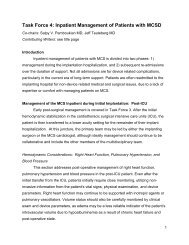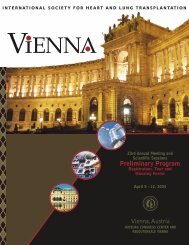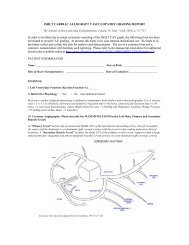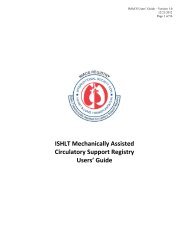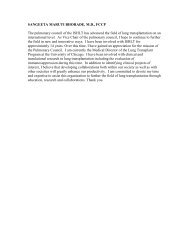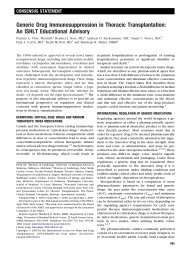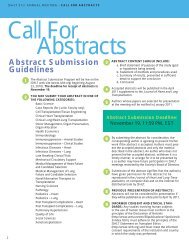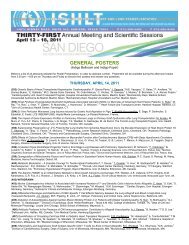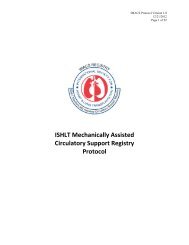Guidelines for the care of heart transplant recipients
Guidelines for the care of heart transplant recipients
Guidelines for the care of heart transplant recipients
You also want an ePaper? Increase the reach of your titles
YUMPU automatically turns print PDFs into web optimized ePapers that Google loves.
Costanzo et al.<br />
<strong>Guidelines</strong> <strong>for</strong> Heart Transplant Care<br />
915<br />
Spain; Delgado R: Texas Heart Institute, Houston, Texas, USA; Dobbels F: Katholieke Universiteit<br />
Leuven, Leuven, Belgium; Grady K: Northwestern University, Chicago, Illlinois, USA; Kao W: University<br />
<strong>of</strong> Wisconsin, Madison Wisconsin, USA; Lamour J: Montefiore Medical Center, New York, New York,<br />
USA; Parry G: Freeman Hospital, Newcastle upon Tyne, UK; Patel J: Cedar-Sinai Heart Institute, Los<br />
Angeles, Cali<strong>for</strong>nia, USA; Pini D: Istituto Clinico Humanitas, Rozzano, Italy; Pinney S: Mount Sinai<br />
Medical Center, New York, New York, USA; Towbin J: Cincinnati Children’s Hospital, Cincinnati, Ohio,<br />
USA; Wolfel G: University <strong>of</strong> Colorado, Denver, Colorado, USA<br />
Independent Reviewers: Delgado D: University <strong>of</strong> Toronto, Toronto, Ontario, Canada; Eisen H: Drexler<br />
University College <strong>of</strong> Medicine, Philadelphia, Pennsylvania, USA; Goldberg L: University <strong>of</strong> Pennsylvania,<br />
Philadelphia, Pennsylvania, USA; Hosenpud J: Mayo Clinic, Jacksonville, Florida, USA; Johnson M:<br />
University <strong>of</strong> Wisconsin, Madison, Wisconsin, USA; Keogh A: St Vincent Hospital, Sidney, New South<br />
Wales, Australia; Lewis C: Papworth Hospital Cambridge, UK; O’Connell J: St. Joseph Hospital, Atlanta,<br />
Georgia, USA; Rogers J: Duke University Medical Center, Durham, North Carolina, USA; Ross H:<br />
University <strong>of</strong> Toronto, Toronto, Ontario, Canada; Russell S: Johns Hopkins Hospital, Baltimore, Maryland,<br />
USA; Vanhaecke J: University Hospital Gasthuisberg, Leuven, Belgium.<br />
J Heart Lung Transplant 2010;29:914–956<br />
© 2010 International Society <strong>for</strong> Heart and Lung Transplantation. All rights reserved.<br />
Since <strong>the</strong> dawn <strong>of</strong> <strong>heart</strong> <strong>transplant</strong>ation in <strong>the</strong> 1960s, <strong>the</strong><br />
medical <strong>care</strong> <strong>of</strong> <strong>heart</strong> <strong>transplant</strong> <strong>recipients</strong> has been<br />
guided by <strong>the</strong> experience <strong>of</strong> individual clinicians and has<br />
varied from center to center. Despite many advances in<br />
surgical techniques, diagnostic approaches, and immunosuppressive<br />
strategies, survival after <strong>heart</strong> <strong>transplant</strong>ation<br />
is limited by <strong>the</strong> development <strong>of</strong> cardiac allograft vasculopathy<br />
and by <strong>the</strong> adverse effects <strong>of</strong> immunosuppression.<br />
The International Society <strong>for</strong> Heart and Lung Transplantation<br />
(ISHLT) has made an unprecedented<br />
commitment to convene experts in all areas <strong>of</strong> <strong>heart</strong><br />
<strong>transplant</strong>ation to develop practice guidelines <strong>for</strong> <strong>the</strong> <strong>care</strong><br />
<strong>of</strong> <strong>heart</strong> <strong>transplant</strong> <strong>recipients</strong>. After a vast ef<strong>for</strong>t involving<br />
40 writers from 9 countries worldwide, <strong>the</strong> ISHLT<br />
<strong>Guidelines</strong> <strong>for</strong> <strong>the</strong> Care <strong>of</strong> Heart Transplant Recipients<br />
have now been completed and <strong>the</strong> Executive Summary <strong>of</strong><br />
<strong>the</strong>se guidelines is <strong>the</strong> subject <strong>of</strong> this article.<br />
The document results from <strong>the</strong> work <strong>of</strong> 3 Task Force<br />
groups:<br />
● Task Force 1 addresses <strong>the</strong> peri-operative <strong>care</strong> <strong>of</strong> <strong>heart</strong><br />
<strong>transplant</strong> <strong>recipients</strong>, including <strong>the</strong> surgical issues affecting<br />
early post-operative <strong>care</strong>; monitoring and treatment <strong>of</strong><br />
early hemodynamic, metabolic, and infectious issues;<br />
evaluation and treatment <strong>of</strong> allosensitization; evaluation<br />
and treatment <strong>of</strong> early coagulopathies; <strong>the</strong> organization <strong>of</strong><br />
a multidisciplinary <strong>care</strong> team; management <strong>of</strong> ABO “incompatible”<br />
pediatric <strong>heart</strong> <strong>transplant</strong>ation; and <strong>the</strong> use <strong>of</strong><br />
extracorporeal membrane oxygenation (ECMO) <strong>for</strong> <strong>the</strong><br />
hemodynamic support <strong>of</strong> pediatric <strong>recipients</strong>.<br />
● Task Force 2 discusses <strong>the</strong> mechanisms, diagnosis, and<br />
treatment <strong>of</strong> <strong>heart</strong> <strong>transplant</strong> rejection; <strong>the</strong> mechanisms <strong>of</strong><br />
action, dosing, and drug level monitoring <strong>of</strong> immunosuppressive<br />
drugs as well as <strong>the</strong>ir adverse effects and interactions<br />
with concomitantly used medications; and reviews<br />
<strong>the</strong> major clinical trials and <strong>the</strong> immunosuppressive<br />
strategies to be used in special clinical situations.<br />
● Task Force 3 covers <strong>the</strong> myriad <strong>of</strong> clinical issues occurring<br />
long-term after <strong>heart</strong> <strong>transplant</strong>ation, including cardiac allograft<br />
vasculopathy, <strong>the</strong> chronic adverse effects <strong>of</strong> immunosuppression<br />
(neurotoxicity, renal insufficiency, hypertension, bone disease,<br />
diabetes and malignancy), as well as reproductive health,<br />
exercise, psychologic problems, return to work, and operation<br />
<strong>of</strong> motor vehicles after <strong>heart</strong> <strong>transplant</strong>ation.<br />
It is important to note that each task <strong>for</strong>ce was co-chaired by<br />
a pediatric <strong>heart</strong> <strong>transplant</strong> physician who had <strong>the</strong> specific<br />
mandate to highlight issues unique to <strong>the</strong> pediatric <strong>heart</strong> <strong>transplant</strong><br />
population and to ensure <strong>the</strong>ir adequate representation.<br />
As <strong>the</strong> reader will undoubtedly observe, most <strong>of</strong> <strong>the</strong> recommendations<br />
only achieve a Level <strong>of</strong> Evidence C, indicating<br />
that <strong>the</strong>se recommendations are based on expert consensus and<br />
not on randomized controlled clinical trials. A concerted ef<strong>for</strong>t<br />
was also made to highlight <strong>the</strong> numerous gaps in evidence<br />
pertaining to many aspects <strong>of</strong> <strong>the</strong> <strong>care</strong> <strong>of</strong> <strong>heart</strong> <strong>transplant</strong><br />
<strong>recipients</strong>. This lack <strong>of</strong> “evidence-based” recommendations is<br />
mostly due to <strong>the</strong> limited number <strong>of</strong> <strong>heart</strong> <strong>transplant</strong> <strong>recipients</strong><br />
worldwide. However, it is <strong>the</strong> hope <strong>of</strong> all contributing writers<br />
and reviewers that <strong>the</strong> increased awareness <strong>of</strong> <strong>the</strong> “gaps in<br />
evidence” provided by <strong>the</strong>se guidelines will spur fur<strong>the</strong>r research<br />
in many important areas <strong>of</strong> <strong>heart</strong> <strong>transplant</strong>ation.<br />
Task Force 1: Peri-operative Care <strong>of</strong> <strong>the</strong> Heart<br />
Transplant Recipient<br />
Chair: Maria Rosa Costanzo, MD; Co-Chairs: Anne Dipchand,<br />
MD; Randall Starling, MD<br />
Contributing Writers: Allen Anderson, MD; Michael<br />
Chan, MD; Shashank Desai, MD; Savitri Fedson, MD; Patrick<br />
Fisher, MD; Gonzalo Gonzales-Stawinski, MD; Luigi Martinelli,<br />
MD; David McGiffin, MD; Jon Smith, MD<br />
Topic 1: Surgical Issues Impacting Care in <strong>the</strong><br />
Immediate Post-operative Period<br />
Recommendations on Donor Heart Selection: 1,2<br />
Class IIa:<br />
1. Taking into consideration only <strong>the</strong> variable <strong>of</strong> “donor age,”<br />
<strong>the</strong> <strong>heart</strong>s <strong>of</strong> donors younger than 45 years will invariably<br />
have sufficient reserves to withstand <strong>the</strong> rigors <strong>of</strong> <strong>heart</strong><br />
<strong>transplant</strong> (HT) even in settings <strong>of</strong> prolonged ischemic<br />
time, recipient comorbidities, and multiple previous recip-



